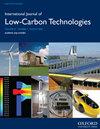相变材料(PCM)层位置对轻量化墙体热工性能的影响
IF 2.3
4区 工程技术
Q3 ENERGY & FUELS
引用次数: 2
摘要
高层建筑通常采用轻质材料来减轻建筑重量,但其热惯性会增加空调和采暖负荷的波动,降低室内热舒适性。采用相变材料(PCM)来改善潜热储热性能,但其位置对轻量化墙体的热性能改善有明显影响。在此条件下,以普通多层墙体为参照,采用PCM层的不同位置,分别将PCM层定位于内侧、PCM层定位于外侧、PCM均匀分布于泡沫混凝土中三种墙体。建立了考虑相变的动态传热模型,并进行了实验验证。数值计算结果表明,在三个位置中,PCM层位于内侧的效果最好,其次是PCM均匀分布在泡沫混凝土中,而PCM层位于外侧的效果最差,尽管液率变化较大。与将PCM层置于外侧并均匀分布在泡沫混凝土中相比,将PCM层置于内侧可使衰减系数降低101.25%和33.87%,延迟时间增加40.00%和17.14%,峰值热流减少47.69%和17.28%。本文章由计算机程序翻译,如有差异,请以英文原文为准。
Location of the phase-change material (PCM) layer on thermal performance of light-weight walls
Light-weight materials are commonly used in high-rise buildings to reduce the building weight, but their thermal inertia will increase the fluctuation of air-conditioning and heating load and reduce indoor thermal comfort. Phase-Change Material (PCM) is employed to improve the thermal behavior by latent thermal storage, but its location has the obvious impact on the thermal behavior improvement of the light-weight wall. According to this condition, by taking the common multi-layer wall as a reference, three walls were built with different locations of the PCM layer, including locating the PCM layer in inner side, locating the PCM layer in outer side, and distributing PCM uniformly into foamed concrete. The dynamic heat transfer model with the phase change had built and verified by an experiment. Numerical results showed locating the PCM layer in inner side is the best in three locations and followed by distributing PCM uniformly into foamed concrete, while locating the PCM layer in outer side is the worst in the spite of the high liquid fraction variation. Locating the PCM layer in inner side can lower the attenuation factor by 101.25% and 33.87%, increase the delay time by 40.00% and 17.14%, reduced by the peak heat flow by 47.69% and 17.28%, compared to locating the PCM layer in outer side and distributing PCM into foamed concrete uniformly.
求助全文
通过发布文献求助,成功后即可免费获取论文全文。
去求助
来源期刊

International Journal of Low-carbon Technologies
Engineering-Architecture
CiteScore
4.30
自引率
4.30%
发文量
106
审稿时长
27 weeks
期刊介绍:
The International Journal of Low-Carbon Technologies is a quarterly publication concerned with the challenge of climate change and its effects on the built environment and sustainability. The Journal publishes original, quality research papers on issues of climate change, sustainable development and the built environment related to architecture, building services engineering, civil engineering, building engineering, urban design and other disciplines. It features in-depth articles, technical notes, review papers, book reviews and special issues devoted to international conferences. The journal encourages submissions related to interdisciplinary research in the built environment. The journal is available in paper and electronic formats. All articles are peer-reviewed by leading experts in the field.
 求助内容:
求助内容: 应助结果提醒方式:
应助结果提醒方式:


